Developmental progression is driven by specific spatiotemporal domains of gene expression, which give rise to stereotypically patterned embryos even in the presence of environmental and genetic variation. Views of how transcription factors regulate gene expression are changing owing to recent genome-wide studies of transcription factor binding and RNA expression. Such studies reveal patterns that, at first glance, seem to contrast with the robustness of the developmental processes they encode. Here, we review our current knowledge of transcription factor function from genomic and genetic studies and discuss how different strategies, including extensive cooperative regulation (both direct and indirect), progressive priming of regulatory elements, and the integration of activities from multiple enhancers, confer specificity and robustness to transcriptional regulation during development.
This is a preview of subscription content, access via your institution
Access options
Subscribe to this journal
Receive 12 print issues and online access
206,07 € per year
only 17,17 € per issue
Buy this article
- Purchase on SpringerLink
- Instant access to full article PDF
Prices may be subject to local taxes which are calculated during checkout
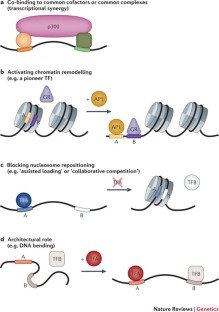
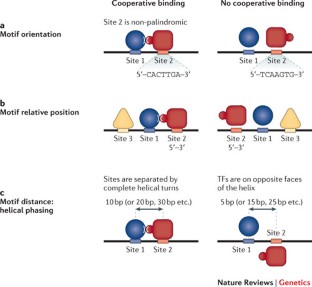
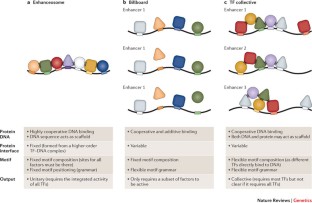
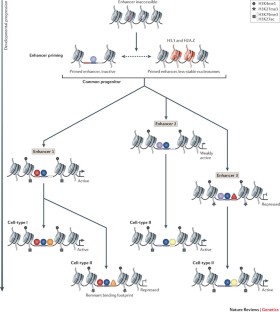
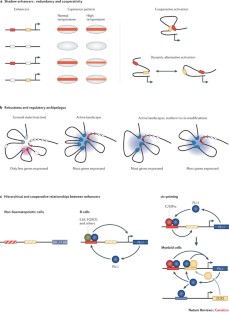
Similar content being viewed by others

The relationship between genome structure and function
Article 24 November 2020
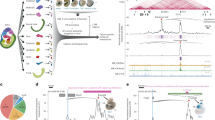
Increased enhancer–promoter interactions during developmental enhancer activation in mammals
Article 20 March 2024
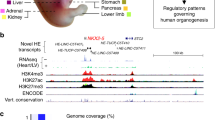
Dynamic changes in the epigenomic landscape regulate human organogenesis and link to developmental disorders
Article Open access 06 August 2020
References
- Davidson, E. H. Emerging properties of animal gene regulatory networks. Nature468, 911–920 (2010). ArticleCASPubMedPubMed CentralGoogle Scholar
- Peter, I. S. & Davidson, E. H. Evolution of gene regulatory networks controlling body plan development. Cell144, 970–985 (2011). ArticleCASPubMedPubMed CentralGoogle Scholar
- Lenhard, B., Sandelin, A. & Carninci, P. Metazoan promoters: emerging characteristics and insights into transcriptional regulation. Nature Rev. Genet.13, 233–245 (2012). ArticleCASPubMedGoogle Scholar
- Levine, M. Transcriptional enhancers in animal development and evolution. Curr. Biol.20, R754–R763 (2010). ArticleCASPubMedPubMed CentralGoogle Scholar
- Bulger, M. & Groudine, M. Functional and mechanistic diversity of distal transcription enhancers. Cell144, 327–339 (2011). ArticleCASPubMedPubMed CentralGoogle Scholar
- Petrykowska, H. M., Vockley, C. M. & Elnitski, L. Detection and characterization of silencers and enhancer-blockers in the greater CFTR locus. Genome Res.18, 1238–1246 (2008). ArticleCASPubMedPubMed CentralGoogle Scholar
- Vokes, S. A., Ji, H., Wong, W. H. & McMahon, A. P. A genome-scale analysis of the cis-regulatory circuitry underlying sonic hedgehog-mediated patterning of the mammalian limb. Genes Dev.22, 2651–2663 (2008). ArticleCASPubMedPubMed CentralGoogle Scholar
- Ayer, S. & Benyajati, C. Conserved enhancer and silencer elements responsible for differential Adh transcription in Drosophila cell lines. Mol. Cell. Biol.10, 3512–3523 (1990). ArticleCASPubMedPubMed CentralGoogle Scholar
- Gaszner, M. & Felsenfeld, G. Insulators: exploiting transcriptional and epigenetic mechanisms. Nature Rev. Genet.7, 703–713 (2006). ArticleCASPubMedGoogle Scholar
- Ohtsuki, S., Levine, M. & Cai, H. N. Different core promoters possess distinct regulatory activities in the Drosophila embryo. Genes Dev.12, 547–556 (1998). ArticleCASPubMedPubMed CentralGoogle Scholar
- Calhoun, V. C., Stathopoulos, A. & Levine, M. Promoter-proximal tethering elements regulate enhancer-promoter specificity in the Drosophila Antennapedia complex. Proc. Natl Acad. Sci. USA99, 9243–9247 (2002). ArticleCASPubMedPubMed CentralGoogle Scholar
- Banerji, J., Rusconi, S. & Schaffner, W. Expression of a β-globin gene is enhanced by remote SV40 DNA sequences. Cell27, 299–308 (1981). ArticleCASPubMedGoogle Scholar
- Small, S., Blair, A. & Levine, M. Regulation of even-skipped stripe 2 in the Drosophila embryo. EMBO J.11, 4047–4057 (1992). ArticleCASPubMedPubMed CentralGoogle Scholar
- Halfon, M. S. et al. Ras pathway specificity is determined by the integration of multiple signal-activated and tissue-restricted transcription factors. Cell103, 63–74 (2000). ArticleCASPubMedGoogle Scholar
- Yuh, C. H., Ransick, A., Martinez, P., Britten, R. J. & Davidson, E. H. Complexity and organization of DNA-protein interactions in the 5′-regulatory region of an endoderm-specific marker gene in the sea urchin embryo. Mech. Dev.47, 165–186 (1994). ArticleCASPubMedGoogle Scholar
- Sandmann, T. et al. A core transcriptional network for early mesoderm development in Drosophila melanogaster. Genes Dev.21, 436–449 (2007). ArticleCASPubMedPubMed CentralGoogle Scholar
- Lettice, L. A. et al. Opposing functions of the ETS factor family define Shh spatial expression in limb buds and underlie polydactyly. Dev. Cell22, 459–467 (2012). ArticleCASPubMedPubMed CentralGoogle Scholar
- Stanojevic, D., Small, S. & Levine, M. Regulation of a segmentation stripe by overlapping activators and repressors in the Drosophila embryo. Science254, 1385–1387 (1991). ArticleCASPubMedGoogle Scholar
- Ip, Y. T., Levine, M. & Small, S. J. The bicoid and dorsal morphogens use a similar strategy to make stripes in the Drosophila embryo. J. Cell Sci. Suppl.16, 33–38 (1992). CASPubMedGoogle Scholar
- Xu, X., Yin, Z., Hudson, J. B., Ferguson, E. L. & Frasch, M. Smad proteins act in combination with synergistic and antagonistic regulators to target Dpp responses to the Drosophila mesoderm. Genes Dev.12, 2354–2370 (1998). ArticleCASPubMedPubMed CentralGoogle Scholar
- Lee, H. H. & Frasch, M. Nuclear integration of positive Dpp signals, antagonistic Wg inputs and mesodermal competence factors during Drosophila visceral mesoderm induction. Development132, 1429–1442 (2005). ArticleCASPubMedGoogle Scholar
- Guss, K. A., Nelson, C. E., Hudson, A., Kraus, M. E. & Carroll, S. B. Control of a genetic regulatory network by a selector gene. Science292, 1164–1167 (2001). ArticleCASPubMedGoogle Scholar
- Mullen, A. C. et al. Master transcription factors determine cell-type-specific responses to TGF-β signaling. Cell147, 565–576 (2011). ArticleCASPubMedPubMed CentralGoogle Scholar
- Trompouki, E. et al. Lineage regulators direct BMP and Wnt pathways to cell-specific programs during differentiation and regeneration. Cell147, 577–589 (2011). ArticleCASPubMedPubMed CentralGoogle Scholar
- Sandmann, T. et al. A temporal map of transcription factor activity: mef2 directly regulates target genes at all stages of muscle development. Dev. Cell10, 797–807 (2006). ArticleCASPubMedGoogle Scholar
- Jakobsen, J. S. et al. Temporal ChIP-on-chip reveals Biniou as a universal regulator of the visceral muscle transcriptional network. Genes Dev.21, 2448–2460 (2007). ArticleCASPubMedPubMed CentralGoogle Scholar
- Cao, Y. et al. Genome-wide MyoD binding in skeletal muscle cells: a potential for broad cellular reprogramming. Dev. Cell18, 662–674 (2010). ArticleCASPubMedPubMed CentralGoogle Scholar
- Lin, Y. C. et al. A global network of transcription factors, involving E2A, EBF1 and Foxo1, that orchestrates B cell fate. Nature Immunol.11, 635–643 (2010). ArticleCASGoogle Scholar
- Pilon, A. M. et al. Genome-wide ChIP-Seq reveals a dramatic shift in the binding of the transcription factor erythroid Kruppel-like factor during erythrocyte differentiation. Blood118, e139–e148 (2011). ArticleCASPubMedPubMed CentralGoogle Scholar
- Gaudet, J. & Mango, S. E. Regulation of organogenesis by the Caenorhabditis elegans FoxA protein PHA-4. Science295, 821–825 (2002). ArticleCASPubMedGoogle Scholar
- Wilczynski, B. & Furlong, E. E. Dynamic CRM occupancy reflects a temporal map of developmental progression. Mol. Syst. Biol.6, 383 (2010). ArticlePubMedPubMed CentralGoogle Scholar
- Yanez-Cuna, J. O., Dinh, H. Q., Kvon, E. Z., Shlyueva, D. & Stark, A. Uncovering cis-regulatory sequence requirements for context specific transcription factor binding. Genome Res. 25 Apr 2012 (doi:10.1101/gr.132811.111). ArticleCASPubMedPubMed CentralGoogle Scholar
- Zeitlinger, J. et al. Program-specific distribution of a transcription factor dependent on partner transcription factor and MAPK signaling. Cell113, 395–404 (2003). ArticleCASPubMedGoogle Scholar
- Biggar, S. R. & Crabtree, G. R. Cell signaling can direct either binary or graded transcriptional responses. EMBO J.20, 3167–3176 (2001). ArticleCASPubMedPubMed CentralGoogle Scholar
- Giorgetti, L. et al. Noncooperative interactions between transcription factors and clustered DNA binding sites enable graded transcriptional responses to environmental inputs. Mol. Cell37, 418–428 (2010). ArticleCASPubMedGoogle Scholar
- Johnson, A. D., Meyer, B. J. & Ptashne, M. Interactions between DNA-bound repressors govern regulation by the lambda phage repressor. Proc. Natl Acad. Sci. USA76, 5061–5065 (1979). ArticleCASPubMedPubMed CentralGoogle Scholar
- Lebrecht, D. et al. Bicoid cooperative DNA binding is critical for embryonic patterning in Drosophila. Proc. Natl Acad. Sci. USA102, 13176–13181 (2005). ArticleCASPubMedPubMed CentralGoogle Scholar
- Zinzen, R. P., Senger, K., Levine, M. & Papatsenko, D. Computational models for neurogenic gene expression in the Drosophila embryo. Curr. Biol.16, 1358–1365 (2006). ArticleCASPubMedGoogle Scholar
- Szymanski, P. & Levine, M. Multiple modes of dorsal-bHLH transcriptional synergy in the Drosophila embryo. EMBO J.14, 2229–2238 (1995). ArticleCASPubMedPubMed CentralGoogle Scholar
- Chopra, V. S. & Levine, M. Combinatorial patterning mechanisms in the Drosophila embryo. Brief. Funct. Genomic. Proteomic.8, 243–249 (2009). ArticlePubMedGoogle Scholar
- Masel, J. & Siegal, M. L. Robustness: mechanisms and consequences. Trends Genet.25, 395–403 (2009). ArticleCASPubMedPubMed CentralGoogle Scholar
- Lin, Y. S., Carey, M., Ptashne, M. & Green, M. R. How different eukaryotic transcriptional activators can cooperate promiscuously. Nature345, 359–361 (1990). ArticleCASPubMedGoogle Scholar
- Merika, M., Williams, A. J., Chen, G., Collins, T. & Thanos, D. Recruitment of CBP/p300 by the IFNβ enhanceosome is required for synergistic activation of transcription. Mol. Cell1, 277–287 (1998). ArticleCASPubMedGoogle Scholar
- Voss, T. C. et al. Dynamic exchange at regulatory elements during chromatin remodeling underlies assisted loading mechanism. Cell146, 544–554 (2011). ArticleCASPubMedPubMed CentralGoogle Scholar
- Miller, J. A. & Widom, J. Collaborative competition mechanism for gene activation in vivo. Mol. Cell. Biol.23, 1623–1632 (2003). ArticleCASPubMedPubMed CentralGoogle Scholar
- Panne, D., Maniatis, T. & Harrison, S. C. An atomic model of the interferon-β enhanceosome. Cell129, 1111–1123 (2007). ArticleCASPubMedPubMed CentralGoogle Scholar
- Falvo, J. V., Thanos, D. & Maniatis, T. Reversal of intrinsic DNA bends in the IFNβ gene enhancer by transcription factors and the architectural protein HMG I(Y). Cell83, 1101–1111 (1995). ArticleCASPubMedGoogle Scholar
- Siggers, T., Duyzend, M. H., Reddy, J., Khan, S. & Bulyk, M. L. Non-DNA-binding cofactors enhance DNA-binding specificity of a transcriptional regulatory complex. Mol. Syst. Biol.7, 555 (2011). This is an interesting study demonstrating that the binding of a cofactor that does not contain a DNA-binding domain can alter the sequence specificity of a transcription factor complex.ArticleCASPubMedPubMed CentralGoogle Scholar
- Noyes, M. B. et al. Analysis of homeodomain specificities allows the family-wide prediction of preferred recognition sites. Cell133, 1277–1289 (2008). ArticleCASPubMedPubMed CentralGoogle Scholar
- Carr, A. & Biggin, M. D. A comparison of in vivo and in vitro DNA-binding specificities suggests a new model for homeoprotein DNA binding in Drosophila embryos. EMBO J.18, 1598–1608 (1999). ArticleCASPubMedPubMed CentralGoogle Scholar
- Slattery, M. et al. Cofactor binding evokes latent differences in DNA binding specificity between hox proteins. Cell147, 1270–1282 (2011). ArticleCASPubMedPubMed CentralGoogle Scholar
- Liu, X., Lee, C. K., Granek, J. A., Clarke, N. D. & Lieb, J. D. Whole-genome comparison of Leu3 binding in vitro and in vivo reveals the importance of nucleosome occupancy in target site selection. Genome Res.16, 1517–1528 (2006). ArticleCASPubMedPubMed CentralGoogle Scholar
- Li, X.-y. et al. The role of chromatin accessibility in directing the widespread, overlapping patterns of Drosophila transcription factor binding. Genome Biol.12, R34 (2011). The authors found that TF occupancy correlates better with DNA accessibility (estimated by DNaseI hypersensitivity) than with predicted sequence affinity, suggesting that this simple property could explain the clustering of TF binding.ArticleCASPubMedPubMed CentralGoogle Scholar
- John, S. et al. Chromatin accessibility pre-determines glucocorticoid receptor binding patterns. Nature Genet.43, 264–268 (2011). ArticleCASPubMedGoogle Scholar
- Degner, J. F. et al. DNase I sensitivity QTLs are a major determinant of human expression variation. Nature482, 390–394 (2012). ArticleCASPubMedPubMed CentralGoogle Scholar
- Buck, M. J. & Lieb, J. D. A chromatin-mediated mechanism for specification of conditional transcription factor targets. Nature Genet.38, 1446–1451 (2006). ArticleCASPubMedGoogle Scholar
- Carr, A. & Biggin, M. D. Accessibility of transcriptionally inactive genes is specifically reduced at homeoprotein-DNA binding sites in Drosophila. Nucleic Acids Res.28, 2839–2846 (2000). ArticleCASPubMedPubMed CentralGoogle Scholar
- John, S. et al. Interaction of the glucocorticoid receptor with the chromatin landscape. Mol. Cell29, 611–624 (2008). ArticleCASPubMedGoogle Scholar
- Vicent, G. P. et al. Two chromatin remodeling activities cooperate during activation of hormone responsive promoters. PLoS Genet.5, e1000567 (2009). ArticleCASPubMedPubMed CentralGoogle Scholar
- Hartley, P. D. & Madhani, H. D. Mechanisms that specify promoter nucleosome location and identity. Cell137, 445–458 (2009). ArticleCASPubMedPubMed CentralGoogle Scholar
- Yarragudi, A., Miyake, T., Li, R. & Morse, R. H. Comparison of ABF1 and RAP1 in chromatin opening and transactivator potentiation in the budding yeast Saccharomyces cerevisiae. Mol. Cell. Biol.24, 9152–9164 (2004). ArticleCASPubMedPubMed CentralGoogle Scholar
- Workman, J. L. & Kingston, R. E. Nucleosome core displacement in vitro via a metastable transcription factor-nucleosome complex. Science258, 1780–1784 (1992). ArticleCASPubMedGoogle Scholar
- Morse, R. H. Nucleosome disruption by transcription factor binding in yeast. Science262, 1563–1566 (1993). ArticleCASPubMedGoogle Scholar
- Barski, A. et al. High-resolution profiling of histone methylations in the human genome. Cell129, 823–837 (2007). ArticleCASPubMedGoogle Scholar
- Kolasinska-Zwierz, P. et al. Differential chromatin marking of introns and expressed exons by H3K36me3. Nature Genet.41, 376–381 (2009). ArticleCASPubMedGoogle Scholar
- Mikkelsen, T. S. et al. Genome-wide maps of chromatin state in pluripotent and lineage-committed cells. Nature448, 553–560 (2007). ArticleCASPubMedPubMed CentralGoogle Scholar
- Heintzman, N. D. et al. Histone modifications at human enhancers reflect global cell-type-specific gene expression. Nature459, 108–112 (2009). ArticleCASPubMedPubMed CentralGoogle Scholar
- Ernst, J. et al. Mapping and analysis of chromatin state dynamics in nine human cell types. Nature473, 43–49 (2011). ArticleCASPubMedPubMed CentralGoogle Scholar
- Heintzman, N. D. & Ren, B. Finding distal regulatory elements in the human genome. Curr. Opin. Genet. Dev.19, 541–549 (2009). ArticleCASPubMedPubMed CentralGoogle Scholar
- Ong, C. T. & Corces, V. G. Enhancer function: new insights into the regulation of tissue-specific gene expression. Nature Rev. Genet.12, 283–293 (2011). ArticleCASPubMedGoogle Scholar
- Creyghton, M. P. et al. Histone H3K27ac separates active from poised enhancers and predicts developmental state. Proc. Natl Acad. Sci. USA107, 21931–21936 (2010). ArticleCASPubMedPubMed CentralGoogle Scholar
- Rada-Iglesias, A. et al. A unique chromatin signature uncovers early developmental enhancers in humans. Nature470, 279–283 (2011). References 71 and 72 identified a strong correlation between the presence of H3K27ac oncis-regulatory elements and the activity of the neighbouring gene, providing the first indication that this mark, rather than H3K4me1, is a good indicator of active regulatory elements.ArticleCASPubMedGoogle Scholar
- Bonn, S. et al. Tissue-specific analysis of chromatin state identifies temporal signatures of enhancer activity during embryonic development. Nature Genet.44, 148–156 (2012). ArticleCASPubMedGoogle Scholar
- Heinz, S. et al. Simple combinations of lineage-determining transcription factors prime cis-regulatory elements required for macrophage and B cell identities. Mol. Cell38, 576–589 (2010). ArticleCASPubMedPubMed CentralGoogle Scholar
- McManus, S. et al. The transcription factor Pax5 regulates its target genes by recruiting chromatin-modifying proteins in committed B cells. EMBO J.30, 2388–2404 (2011). ArticleCASPubMedPubMed CentralGoogle Scholar
- Ghisletti, S. et al. Identification and characterization of enhancers controlling the inflammatory gene expression program in macrophages. Immunity32, 317–328 (2010). ArticleCASPubMedGoogle Scholar
- Mercer, E. M. et al. Multilineage priming of enhancer repertoires precedes commitment to the B and myeloid cell lineages in hematopoietic progenitors. Immunity35, 413–425 (2011). ArticleCASPubMedPubMed CentralGoogle Scholar
- Flames, N. & Hobert, O. Gene regulatory logic of dopamine neuron differentiation. Nature458, 885–889 (2009). ArticleCASPubMedPubMed CentralGoogle Scholar
- Zinzen, R. P., Girardot, C., Gagneur, J., Braun, M. & Furlong, E. E. Combinatorial binding predicts spatio-temporal cis-regulatory activity. Nature462, 65–70 (2009). ArticleCASPubMedGoogle Scholar
- Brody, T. et al. Use of a Drosophila genome-wide conserved sequence database to identify functionally related cis-regulatory enhancers. Dev. Dyn.241, 169–189 (2012). ArticleCASPubMedGoogle Scholar
- Kaplan, T. et al. Quantitative models of the mechanisms that control genome-wide patterns of transcription factor binding during early Drosophila development. PLoS Genet.7, e1001290 (2011). ArticleCASPubMedPubMed CentralGoogle Scholar
- Narlikar, L. et al. Genome-wide discovery of human heart enhancers. Genome Res.20, 381–392 (2010). ArticleCASPubMedPubMed CentralGoogle Scholar
- Senger, K. et al. Immunity regulatory DNAs share common organizational features in Drosophila. Mol. Cell13, 19–32 (2004). ArticleCASPubMedGoogle Scholar
- Swanson, C. I., Evans, N. C. & Barolo, S. Structural rules and complex regulatory circuitry constrain expression of a Notch- and EGFR-regulated eye enhancer. Dev. Cell18, 359–370 (2010). By carrying out an extensive mutagenesis analysis, this elegant study found that the sequence of aD. melanogasterenhancer is highly constrained, with the presence and relative positioning of almost all sequence motifs being essential for some aspect of the enhancer's activity. Interestingly, in otherDrosophilaspecies, the homologous enhancer adopted different 'solutions' to give the same activity.ArticleCASPubMedPubMed CentralGoogle Scholar
- Thanos, D. & Maniatis, T. Virus induction of human IFNβ gene expression requires the assembly of an enhanceosome. Cell83, 1091–1100 (1995). ArticleCASPubMedGoogle Scholar
- Merika, M. & Thanos, D. Enhanceosomes. Curr. Opin. Genet. Dev.11, 205–208 (2001). ArticleCASPubMedGoogle Scholar
- Kulkarni, M. M. & Arnosti, D. N. Information display by transcriptional enhancers. Development130, 6569–6575 (2003). ArticleCASPubMedGoogle Scholar
- Arnosti, D. N. & Kulkarni, M. M. Transcriptional enhancers: intelligent enhanceosomes or flexible billboards? J. Cell. Biochem.94, 890–898 (2005). ArticleCASGoogle Scholar
- Brown, C. D., Johnson, D. S. & Sidow, A. Functional architecture and evolution of transcriptional elements that drive gene coexpression. Science317, 1557–1560 (2007). ArticleCASPubMedGoogle Scholar
- Liberman, L. M. & Stathopoulos, A. Design flexibility in cis-regulatory control of gene expression: synthetic and comparative evidence. Dev. Biol.327, 578–589 (2009). ArticleCASPubMedGoogle Scholar
- Junion, G. et al. A transcription factor collective defines cardiac cell fate and reflects lineage history. Cell148, 473–486 (2012). ArticleCASPubMedGoogle Scholar
- Gao, F., Foat, B. C. & Bussemaker, H. J. Defining transcriptional networks through integrative modeling of mRNA expression and transcription factor binding data. BMC Bioinformatics5, 31 (2004). ArticlePubMedPubMed CentralGoogle Scholar
- Ucar, D., Beyer, A., Parthasarathy, S. & Workman, C. T. Predicting functionality of protein-DNA interactions by integrating diverse evidence. Bioinformatics25, i137–i144 (2009). ArticleCASPubMedPubMed CentralGoogle Scholar
- Krejci, A., Bernard, F., Housden, B. E., Collins, S. & Bray, S. J. Direct response to Notch activation: signaling crosstalk and incoherent logic. Sci. Signal.2, ra1 (2009). ArticleCASPubMedGoogle Scholar
- Zaret, K. S. & Carroll, J. S. Pioneer transcription factors: establishing competence for gene expression. Genes Dev.25, 2227–2241 (2011). ArticleCASPubMedPubMed CentralGoogle Scholar
- Biswas, A. K. & Johnson, D. G. Transcriptional and nontranscriptional functions of E2F1 in response to DNA damage. Cancer Res.72, 13–17 (2012). ArticleCASPubMedGoogle Scholar
- Lickwar, C. R., Mueller, F., Hanlon, S. E., McNally, J. G. & Lieb, J. D. Genome-wide protein-DNA binding dynamics suggest a molecular clutch for transcription factor function. Nature484, 251–255 (2012). The authors tagged a transcription factor with two different tags and carried out a competitive ChIP assay to measure how long it took for the newly transcribed tagged TF to outcompete its alternatively tagged counterpart for chromatin binding. The resulting information provides a nice way to measure TF residence time on each site throughout the genome, which seems to be a better indicator of functional binding events than static occupancy data.ArticleCASPubMedPubMed CentralGoogle Scholar
- Tagoh, H. et al. Epigenetic silencing of the c-fms locus during B-lymphopoiesis occurs in discrete steps and is reversible. EMBO J.23, 4275–4285 (2004). ArticleCASPubMedPubMed CentralGoogle Scholar
- Krysinska, H. et al. A two-step, PU.1-dependent mechanism for developmentally regulated chromatin remodeling and transcription of the c-fms gene. Mol. Cell. Biol.27, 878–887 (2007). ArticleCASPubMedGoogle Scholar
- Almer, A., Rudolph, H., Hinnen, A. & Horz, W. Removal of positioned nucleosomes from the yeast PHO5 promoter upon PHO5 induction releases additional upstream activating DNA elements. EMBO J.5, 2689–2696 (1986). ArticleCASPubMedPubMed CentralGoogle Scholar
- Biddie, S. C. et al. Transcription factor AP1 potentiates chromatin accessibility and glucocorticoid receptor binding. Mol. Cell43, 145–155 (2011). ArticleCASPubMedPubMed CentralGoogle Scholar
- de la Serna, I. L. et al. MyoD targets chromatin remodeling complexes to the myogenin locus prior to forming a stable DNA-bound complex. Mol. Cell. Biol.25, 3997–4009 (2005). ArticleCASPubMedPubMed CentralGoogle Scholar
- Lupien, M. et al. FoxA1 translates epigenetic signatures into enhancer-driven lineage-specific transcription. Cell132, 958–970 (2008). This study shows that FOXA1 occupancy correlates with the prior presence of H3K4me2 at specific enhancer elements. This histone modification directs FOXA1 to induce further chromatin remodelling and TF occupancy specifically at those enhancers. This suggests that even what is perceived as a pioneer factor requires a prior chromatin context.ArticleCASPubMedPubMed CentralGoogle Scholar
- Siersbæk, R. et al. Extensive chromatin remodelling and establishment of transcription factor 'hotspots' during early adipogenesis. EMBO J.30, 1459–1472 (2011). ArticleCASPubMedPubMed CentralGoogle Scholar
- Liber, D. et al. Epigenetic priming of a pre-B cell-specific enhancer through binding of Sox2 and Foxd3 at the ESC stage. Cell Stem Cell7, 114–126 (2010). ArticleCASPubMedGoogle Scholar
- Xu, J. et al. Transcriptional competence and the active marking of tissue-specific enhancers by defined transcription factors in embryonic and induced pluripotent stem cells. Genes Dev.23, 2824–2838 (2009). ArticleCASPubMedPubMed CentralGoogle Scholar
- Hoogenkamp, M. et al. Early chromatin unfolding by RUNX1: a molecular explanation for differential requirements during specification versus maintenance of the hematopoietic gene expression program. Blood114, 299–309 (2009). ArticleCASPubMedPubMed CentralGoogle Scholar
- Liang, H. L. et al. The zinc-finger protein Zelda is a key activator of the early zygotic genome in Drosophila. Nature456, 400–403 (2008). ArticleCASPubMedPubMed CentralGoogle Scholar
- Nien, C. Y. et al. Temporal coordination of gene networks by Zelda in the early Drosophila embryo. PLoS Genet.7, e1002339 (2011). ArticleCASPubMedPubMed CentralGoogle Scholar
- Harrison, M. M., Li, X.-y., Kaplan, T., Botchan, M. R. & Eisen, M. B. Zelda binding in the early Drosophila melanogaster embryo marks regions subsequently activated at the maternal-to-zygotic transition. PLoS Genet.7, e1002266 (2011). References 109 and 110 indicate that Zelda is a major global regulator of the MZT inD. melanogaster. Zelda binds to thousands of regulatory elements prior to the MZT and prior to the occupancy of other known factors and is required for the zygotic gene activation of a large number of genes.ArticleCASPubMedPubMed CentralGoogle Scholar
- Struffi, P. et al. Combinatorial activation and concentration-dependent repression of the Drosophila even skipped stripe 3 + 7 enhancer. Development138, 4291–4299 (2011). ArticleCASPubMedPubMed CentralGoogle Scholar
- Bell, O., Tiwari, V. K., Thoma, N. H. & Schubeler, D. Determinants and dynamics of genome accessibility. Nature Rev. Genet.12, 554–564 (2011). ArticleCASPubMedGoogle Scholar
- Xu, J. et al. Pioneer factor interactions and unmethylated CpG dinucleotides mark silent tissue-specific enhancers in embryonic stem cells. Proc. Natl Acad. Sci. USA104, 12377–12382 (2007). ArticleCASPubMedPubMed CentralGoogle Scholar
- Serandour, A. A. et al. Epigenetic switch involved in activation of pioneer factor FOXA1-dependent enhancers. Genome Res.21, 555–565 (2011). ArticleCASPubMedPubMed CentralGoogle Scholar
- Stadler, M. B. et al. DNA-binding factors shape the mouse methylome at distal regulatory regions. Nature480, 490–495 (2011). CASPubMedGoogle Scholar
- Pevny, L. & Placzek, M. SOX genes and neural progenitor identity. Curr. Opin. Neurobiol.15, 7–13 (2005). ArticleCASPubMedGoogle Scholar
- Olson, E. N. & Klein, W. H. bHLH factors in muscle development: dead lines and commitments, what to leave in and what to leave out. Genes Dev.8, 1–8 (1994). ArticleCASPubMedGoogle Scholar
- Bergsland, M. et al. Sequentially acting Sox transcription factors in neural lineage development. Genes Dev.25, 2453–2464 (2011). ArticleCASPubMedPubMed CentralGoogle Scholar
- Cui, K. et al. Chromatin signatures in multipotent human hematopoietic stem cells indicate the fate of bivalent genes during differentiation. Cell Stem Cell4, 80–93 (2009). ArticleCASPubMedPubMed CentralGoogle Scholar
- Watts, J. A. et al. Study of FoxA pioneer factor at silent genes reveals Rfx-repressed enhancer at Cdx2 and a potential indicator of esophageal adenocarcinoma development. PLoS Genet.7, e1002277 (2011). ArticleCASPubMedPubMed CentralGoogle Scholar
- Zeitlinger, J. et al. Whole-genome ChIP-chip analysis of Dorsal, Twist, and Snail suggests integration of diverse patterning processes in the Drosophila embryo. Genes Dev.21, 385–390 (2007). ArticleCASPubMedPubMed CentralGoogle Scholar
- Hong, J. W., Hendrix, D. A. & Levine, M. S. Shadow enhancers as a source of evolutionary novelty. Science321, 1314 (2008). ArticleCASPubMedPubMed CentralGoogle Scholar
- Barolo, S. Shadow enhancers: frequently asked questions about distributed cis-regulatory information and enhancer redundancy. Bioessays34, 135–141 (2012). ArticleCASPubMedGoogle Scholar
- Frankel, N. et al. Phenotypic robustness conferred by apparently redundant transcriptional enhancers. Nature466, 490–493 (2010). ArticleCASPubMedPubMed CentralGoogle Scholar
- Perry, M. W., Boettiger, A. N., Bothma, J. P. & Levine, M. Shadow enhancers foster robustness of Drosophila gastrulation. Curr. Biol.20, 1562–1567 (2010). Developmental genes often have multiple enhancers that seem to have overlapping activities and functions under normal developmental conditions. References 124 and 125 showed that the removal of one (or both) of the enhancers leads to developmental defects when the environmental conditions are more extreme, indicating that 'shadow' enhancers provide robustness to gene expression in the midst of fluctuating environmental temperatures.ArticleCASPubMedPubMed CentralGoogle Scholar
- Barolo, S. & Levine, M. hairy mediates dominant repression in the Drosophila embryo. EMBO J.16, 2883–2891 (1997). ArticleCASPubMedPubMed CentralGoogle Scholar
- Perry, M. W., Boettiger, A. N. & Levine, M. Multiple enhancers ensure precision of gap gene-expression patterns in the Drosophila embryo. Proc. Natl Acad. Sci. USA108, 13570–13575 (2011). ArticleCASPubMedPubMed CentralGoogle Scholar
- Yao, L.-C. et al. Multiple modular promoter elements drive graded brinker expression in response to the Dpp morphogen gradient. Development135, 2183–2192 (2008). ArticleCASPubMedGoogle Scholar
- Prazak, L., Fujioka, M. & Gergen, J. P. Non-additive interactions involving two distinct elements mediate sloppy-paired regulation by pair-rule transcription factors. Dev. Biol.344, 1048–1059 (2010). ArticleCASPubMedPubMed CentralGoogle Scholar
- Spitz, F., Gonzalez, F. & Duboule, D. A global control region defines a chromosomal regulatory landscape containing the HoxD cluster. Cell113, 405–417 (2003). ArticleCASPubMedGoogle Scholar
- Gonzalez, F., Duboule, D. & Spitz, F. Transgenic analysis of Hoxd gene regulation during digit development. Dev Biol.306, 847–859 (2007). ArticleCASPubMedGoogle Scholar
- Montavon, T. et al. A regulatory archipelago controls Hox genes transcription in digits. Cell147, 1132–1145 (2011). Genetic and transgenic analyses showed that mouseHoxDgenes are controlled by many remote regulatory elements that are separated by large distances. Chromatin conformation capture experiments revealed that these elements come together in cells where they contribute toHoxDgene expression, providing a three-dimensional view of the complex folding of regulatory landscapes during embryonic development.ArticleCASPubMedGoogle Scholar
- Suter, D. M. et al. Mammalian genes are transcribed with widely different bursting kinetics. Science332, 472–474 (2011). ArticleCASPubMedGoogle Scholar
- Amano, T. et al. Chromosomal dynamics at the Shh locus: limb bud-specific differential regulation of competence and active transcription. Dev. Cell16, 47–57 (2008). ArticleCASPubMedGoogle Scholar
- Jeong, Y., El-Jaick, K., Roessler, E., Muenke, M. & Epstein, D. J. A functional screen for sonic hedgehog regulatory elements across a 1 Mb interval identifies long-range ventral forebrain enhancers. Development133, 761–772 (2006). ArticleCASPubMedGoogle Scholar
- Leddin, M. et al. Two distinct auto-regulatory loops operate at the PU.1 locus in B cells and myeloid cells. Blood117, 2827–2838 (2011). ArticleCASPubMedPubMed CentralGoogle Scholar
- Jack, J. & DeLotto, Y. Structure and regulation of a complex locus: the cut gene of Drosophila. Genetics139, 1689–1700 (1995). CASPubMedPubMed CentralGoogle Scholar
- Wunderle, V. M., Critcher, R., Hastie, N., Goodfellow, P. N. & Schedl, A. Deletion of long-range regulatory elements upstream of SOX9 causes campomelic dysplasia. Proc. Natl Acad. Sci. USA95, 10649–10654 (1998). ArticleCASPubMedPubMed CentralGoogle Scholar
- Sagai, T., Hosoya, M., Mizushina, Y., Tamura, M. & Shiroishi, T. Elimination of a long-range cis-regulatory module causes complete loss of limb-specific Shh expression and truncation of the mouse limb. Development132, 797–803 (2005). ArticleCASPubMedGoogle Scholar
- Visel, A., Rubin, E. M. & Pennacchio, L. A. Genomic views of distant-acting enhancers. Nature461, 199–205 (2009). ArticleCASPubMedPubMed CentralGoogle Scholar
- Splinter, E. & de Laat, W. The complex transcription regulatory landscape of our genome: control in three dimensions. EMBO J.30, 4345–4355 (2011). ArticleCASPubMedPubMed CentralGoogle Scholar
- Butler, J. E. & Kadonaga, J. T. Enhancer-promoter specificity mediated by DPE or TATA core promoter motifs. Genes Dev.15, 2515–2519 (2001). ArticleCASPubMedPubMed CentralGoogle Scholar
- Zuniga, A. et al. Mouse limb deformity mutations disrupt a global control region within the large regulatory landscape required for Gremlin expression. Genes Dev.18, 1553–1564 (2004). ArticleCASPubMedPubMed CentralGoogle Scholar
- Cajiao, I., Zhang, A., Yoo, E. J., Cooke, N. E. & Liebhaber, S. A. Bystander gene activation by a locus control region. EMBO J.23, 3854–3863 (2004). ArticleCASPubMedPubMed CentralGoogle Scholar
- Lower, K. M. et al. Adventitious changes in long-range gene expression caused by polymorphic structural variation and promoter competition. Proc. Natl Acad. Sci. USA106, 21771–21776 (2009). ArticleCASPubMedPubMed CentralGoogle Scholar
- Ruf, S. et al. Large-scale analysis of the regulatory architecture of the mouse genome with a transposon-associated sensor. Nature Genet.43, 379–386 (2011). ArticleCASPubMedGoogle Scholar
- Klopocki, E. et al. A microduplication of the long range SHH limb regulator (ZRS) is associated with triphalangeal thumb-polysyndactyly syndrome. J. Med. Genet.45, 370–375 (2008). ArticleCASPubMedGoogle Scholar
- Kurth, I. et al. Duplications of noncoding elements 5′ of SOX9 are associated with brachydactyly-anonychia. Nature Genet.41, 862–863 (2009). ArticleCASPubMedGoogle Scholar
- Dathe, K. et al. Duplications involving a conserved regulatory element downstream of BMP2 are associated with brachydactyly type A2. Am. J. Hum. Genet.84, 483–492 (2009). ArticleCASPubMedPubMed CentralGoogle Scholar
- Cande, J., Goltsev, Y. & Levine, M. S. Conservation of enhancer location in divergent insects. Proc. Natl Acad. Sci. USA106, 14414–14419 (2009). ArticleCASPubMedPubMed CentralGoogle Scholar
- Mongin, E., Dewar, K. & Blanchette, M. Long-range regulation is a major driving force in maintaining genome integrity. BMC Evol. Biol.9, 203 (2009). ArticleCASPubMedPubMed CentralGoogle Scholar
- Engstrom, P. G., Ho Sui, S. J., Drivenes, O., Becker, T. S. & Lenhard, B. Genomic regulatory blocks underlie extensive microsynteny conservation in insects. Genome Res.17, 1898–1908 (2007). ArticleCASPubMedPubMed CentralGoogle Scholar
- Dixon, J. R. et al. Topological domains in mammalian genomes identified by analysis of chromatin interactions. Nature485, 376–380 (2012). ArticleCASPubMedPubMed CentralGoogle Scholar
- Lieberman-Aiden, E. et al. Comprehensive mapping of long-range interactions reveals folding principles of the human genome. Science326, 289–293 (2009). ArticleCASPubMedPubMed CentralGoogle Scholar
- Nora, E. P. et al. Spatial partitioning of the regulatory landscape of the X-inactivation centre. Nature485, 381–385 (2012). ArticleCASPubMedPubMed CentralGoogle Scholar
- Ludwig, M. Z., Manu, Kittler, R., White, K. P. & Kreitman, M. Consequences of eukaryotic enhancer architecture for gene expression dynamics, development, and fitness. PLoS Genet.7, e1002364 (2011). ArticleCASPubMedPubMed CentralGoogle Scholar
- Janssens, H. et al. Quantitative and predictive model of transcriptional control of the Drosophila melanogaster even skipped gene. Nature Genet.38, 1159–1165 (2006). ArticleCASPubMedGoogle Scholar
- Klingler, M., Soong, J., Butler, B. & Gergen, J. P. Disperse versus compact elements for the regulation of runt stripes in Drosophila. Dev. Biol.177, 73–84 (1996). ArticleCASPubMedGoogle Scholar
- MacArthur, S. et al. Developmental roles of 21 Drosophila transcription factors are determined by quantitative differences in binding to an overlapping set of thousands of genomic regions. Genome Biol.10, R80 (2009). ArticleCASPubMedPubMed CentralGoogle Scholar
- Liu, Y. H. et al. A systematic analysis of Tinman function reveals Eya and JAK-STAT signaling as essential regulators of muscle development. Dev. Cell16, 280–291 (2009). ArticleCASPubMedGoogle Scholar
- Zheng, J. et al. Epistatic relationships reveal the functional organization of yeast transcription factors. Mol. Syst. Biol.6, 420 (2010). ArticleCASPubMedPubMed CentralGoogle Scholar
Acknowledgements
We are very grateful to J. Erceg, D. Harnett and P. Khoueiry for useful comments, with particular thanks to R. Zinzen and D. Garfield for some rephrasing. We apologize to all colleagues whose work was omitted due to space limitations; we unfortunately could not comment on all the interesting papers in the field. F.S. is supported by grants from the Human Frontier Science Program (HFSP), a European Commission grant (EC-FP7, grant Health 223210/CISSTEM). E.E.M.F. is supported by grants from the HFSP, the European Research Area for Systems Biology (ERASysBio) for the ModHeart project and the German Research Foundation (DFG; grant FU 750/1-1).









